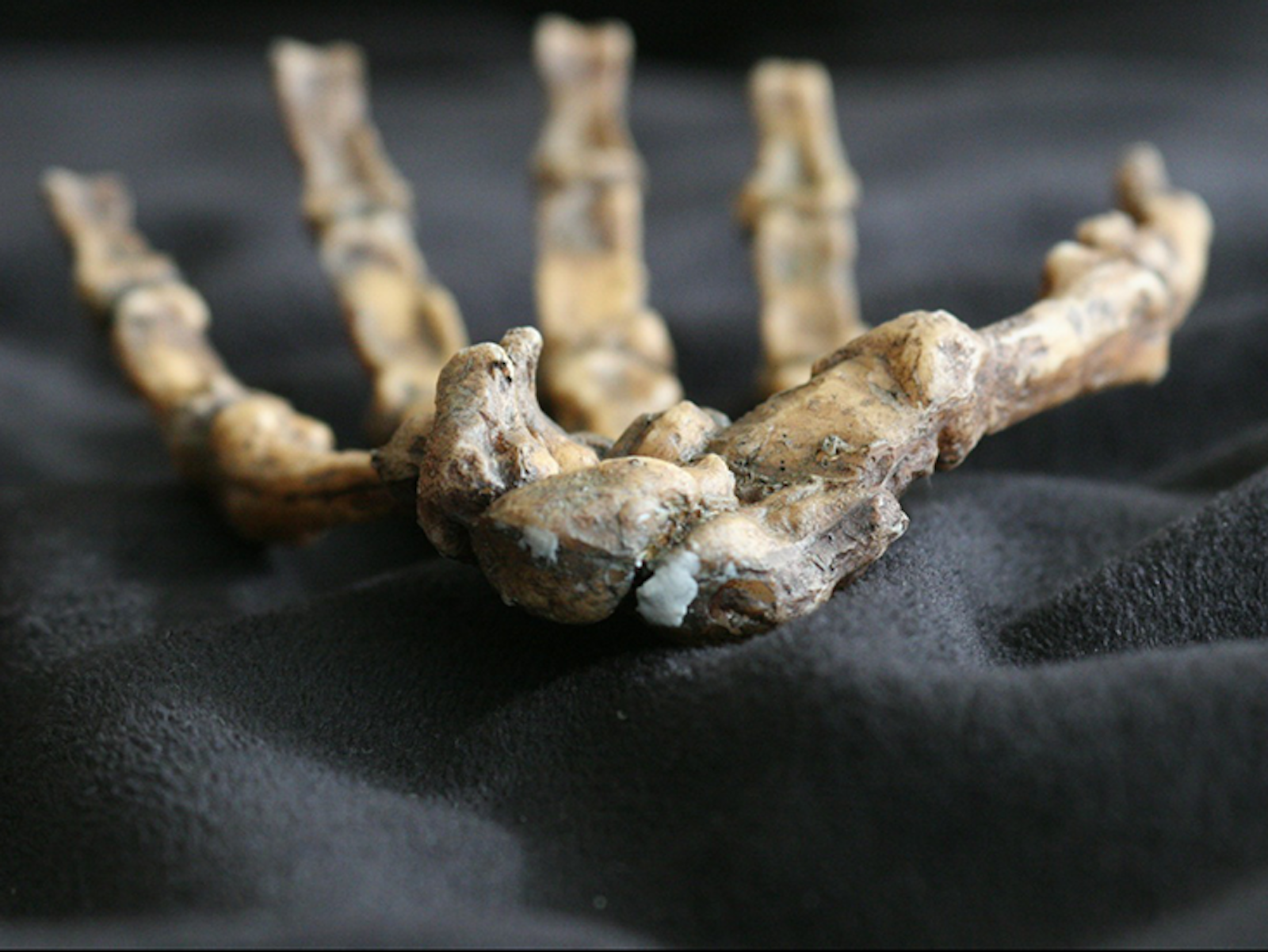What a waste are two thumbs on the space bar. There they sit, nearly flaccid, punctuating the end of each word, awaiting the call to crack stone or to use sharp flakes to incise wood.
It is easy to think of other traits as making us human. We talk, use metaphors, empathize, follow fashions, laugh, play politics and Angry Birds. But many of us still work with our hands, crafting fine objects or simple tools, digging and harvesting. Or texting. As they have always done, thumbs and fingers connect us to our social lives.
No living ape has such digits, each long thumb with its own wide, flat fingertip bone. Ape thumbs are short afterthoughts, jutting awkwardly below the long, strong bones of the hand. No ape supplies each thumb with its own flexor pollicis longus, deep in the forearm. This muscle pulls powerfully on the thumb bones, clamping them forcefully onto the stone. The pinky bones, too, get into the act, flexing inward to cup the palm around a rock. No ape has a pinky as mobile as ours, or short fingers with broad fingertips. Those wide fingertips, wider than any ape or monkey’s, spread the pressure over a broader surface, making the grip fast against the percussive rebound as the stone wallops into another at the abrupt end of its arm-driven ballistic path.
Toolmaking is not ours alone. Primatologists have known for more than 50 years that apes make and use tools in their natural habitats. Even in Charles Darwin’s time, the manipulatory abilities of monkeys and apes were widely known. Today we can watch as a chimpanzee makes delicate termite probes, using hands that are built like meat hooks. All living apes have long and powerful fingers, each finger phalanx wrapped with a strong sheath enclosing the cable-like tendon that stretches from arm to fingertip. Their anatomy gives them a forceful curling grip that no human can match, but little control at the fingertips.
Only after long training could Kanzi, the famous bonobo, chip flakes comparable to the earliest artifacts made my human ancestors. The problem was not his brain: He seemed perfectly to understand the utility of the flake, how and why to cut things with the sharp edge. The hard part was mechanical: controlling the arms and hands without a powerful fingertip hold.
The proportions of our hand, including our long thumb and relatively short fingers, emerged early in the human lineage, over 3 million years ago. The species of the famous “Lucy” skeleton, Australopithecus afarensis, had digits proportioned much like ours, very different from chimpanzees and other apes. The thumbs of some of these early ancestors were equipped with the flexor pollicis longus muscle, though they were generally weakly developed. The muscle within the fleshy mound at the base of the thumb was likewise weak. These were not hands for making stone tools, not yet. The broad fingertips and manipulatory abilities of later humans came later. The hands of Au. afarensis kept strong flexor tendons and curved finger bones, likely because the species still used its hands to climb and cling to branches. Like Kanzi’s hands, these were useful both for using tools and climbing, but not for inventing tools from stone.
As anthropologists probe deeper into the origins of humans, they naturally emphasize the brain. They point to the brain’s rapid enlargement during the past two million years, the expansion of the neocortex relative to the whole brain and the apparent reorganization of cortical areas of the frontal lobes. The brain’s evolution touches upon all those behaviors that seem to separate us so clearly from other creatures: language, social complexity, invention. Individually, these features overlap with other primates, but in each case evolution has tweaked existing abilities to enable new cultural abilities in the human lineage. Even when they consider early toolkits, archaeologists often write of the cognitive abilities and behaviors driving tool use—selecting raw materials, transporting carcasses, organizing food sharing. Functional MRI scans have even shown the recruitment of brain areas as expert stone-tool-makers visualize their craft. One assumption underlies much of this thinking: technology may make us human, but the brain is in the driver’s seat.
So isn’t it interesting how natural it seems to describe this evolution—“point,” “probe,” “touch,” “tweak”—with terms that apply to our hands?
Among the first cave paintings are outlines of human hands—living stencils outlined by blown-on pigments.
Did hands make us human? Did they allow our ancestors to finish the climb out of the trees and enable them to become the uniquely intelligent, social, adaptable primate that colonized the planet? The discovery of a boy’s skeleton in Olduvai Gorge in 1960 made it seem that stone tool manufacture, larger brains, and human hand anatomy evolved together. The boy was around 10 years old when he died, leaving us a fragmentary braincase, a jaw, and bones from his right hand. Broad fingertips and a very mobile joint between the wrist and metacarpal for the thumb gave the right anatomical signs for stone toolmaking. Olduvai Gorge was also where anthropologists were finding the earliest known tools. Believing they had found the toolmaker, discoverers Louis and Mary Leakey and the describer Phillip Tobias called the fossil Homo habilis: “handy man.”
But from this simple picture, our understanding of human hand evolution has dramatically shifted during the last several years. Two million years ago, a quarter-million years before the Homo habilis boy, the species Australopithecus sediba lived on the high plains of South Africa. This species had small bodies and brains, but hands (pictured above) that were more human in some ways than Homo habilis, with stronger flexor pollicis longus muscles; flatter, straighter finger bones; and some details of the wrist made to absorb the compression coming from powerful blows. Au. sediba had a tiny hand compared to living people, but it shares many of the key features useful for stone tool manufacture. Today, the earliest known stone tools are 2.6 million years old, and by the time of Au. sediba, somebody—maybe even a broad array of species—left toolkits for archaeologists intensively analyze. We know, judging by which stone outcrops the materials came, that they appreciated the fracture mechanics of the rock. We know how the tool-users took apart animal carcasses, transported the parts, and smashed into marrow cavities. But what archaeologists cannot do is place the tools into the hands of any particular species. Until we know how tools really fit into the lives of these later australopithecines, the steps leading up to the more complex brains of our genus may remain a mystery.
Hand evolution did not end with the appearance of Homo, as later people continued to increase the muscular power and bony strength of their hands. Along with our cognitive talent for invention, we require a more mechanical facility: hands capable of building and precisely controlling the tools we imagine.
Since the beginning, we’ve also been using those hands to communicate. Among the first cave paintings are outlines of human hands—living stencils outlined by blown-on pigments. These traces come only from the last stage of our evolutionary journey, but even here we see how pointing and touching are so fundamental to human communication. Humans talk, but even simpler, we point. Psychologists studying learning in human children and chimpanzee juveniles have found that a key difference between our two species is the ability to share attention jointly with another, more experienced individual. When a mother holds a toy in her hands and names it, the child can learn that word. When a mother points at the toy later on, the child will understand. By directing attention with our hands, early humans may have laid the groundwork for spoken language.
And now, we type and text.
When it comes to the information content of human imagination, statisticians and information theorists sometimes muse about one question: How long would it take a million monkeys to type the works of William Shakespeare?
As an anthropologist, I have to believe this is going to take even longer than they expect: Without the individual finger control for touch typing, the million monkeys will have to hunt and peck.
John Hawks is a paleoanthropologist at the University of Wisconsin-Madison, investigating the Neandertals and recent human evolution. His blog follows research and the development of his upcoming massive open online course in human evolution.
This class Facts So Romantic post was originally published in May, 2013.






























